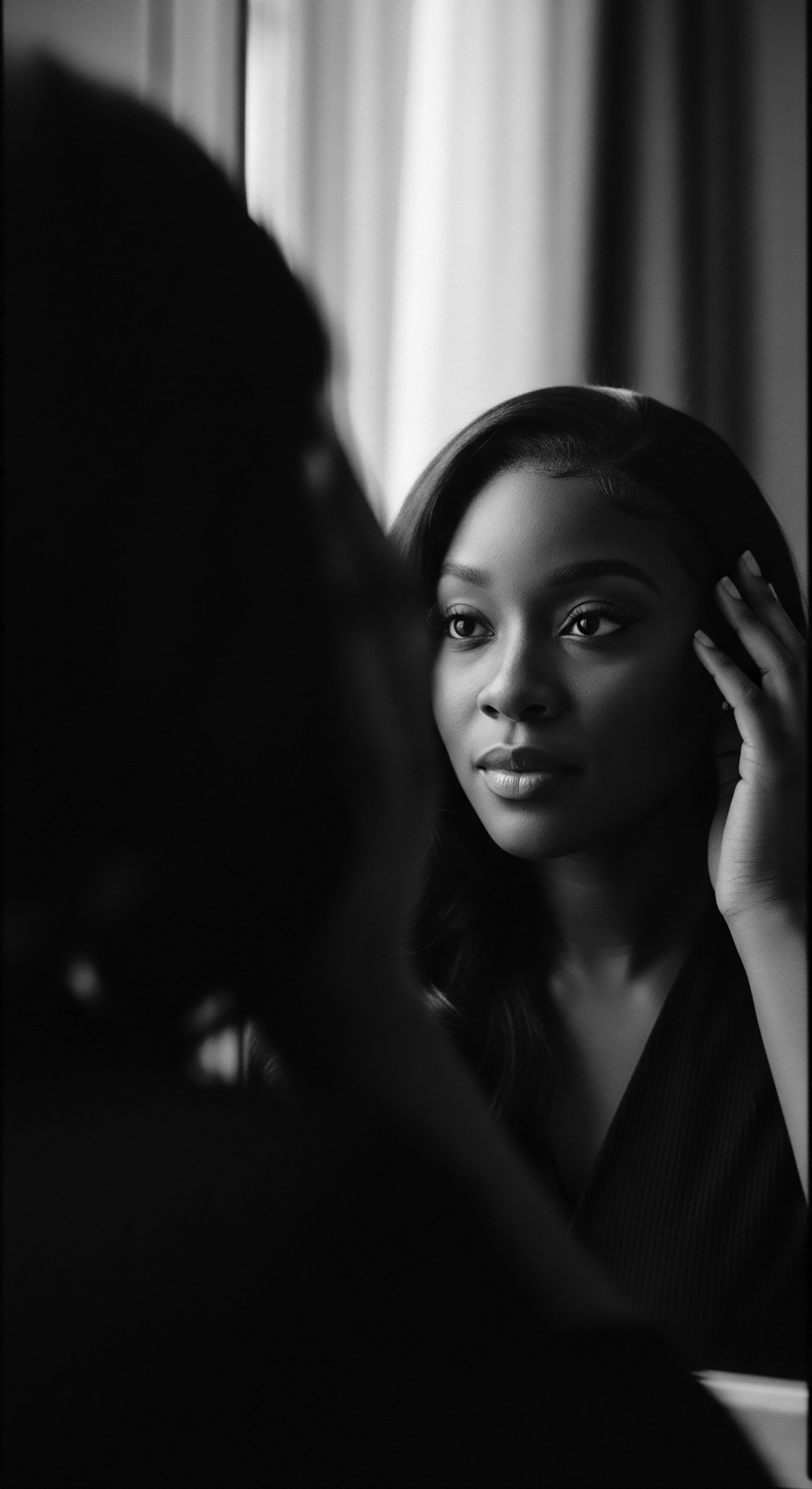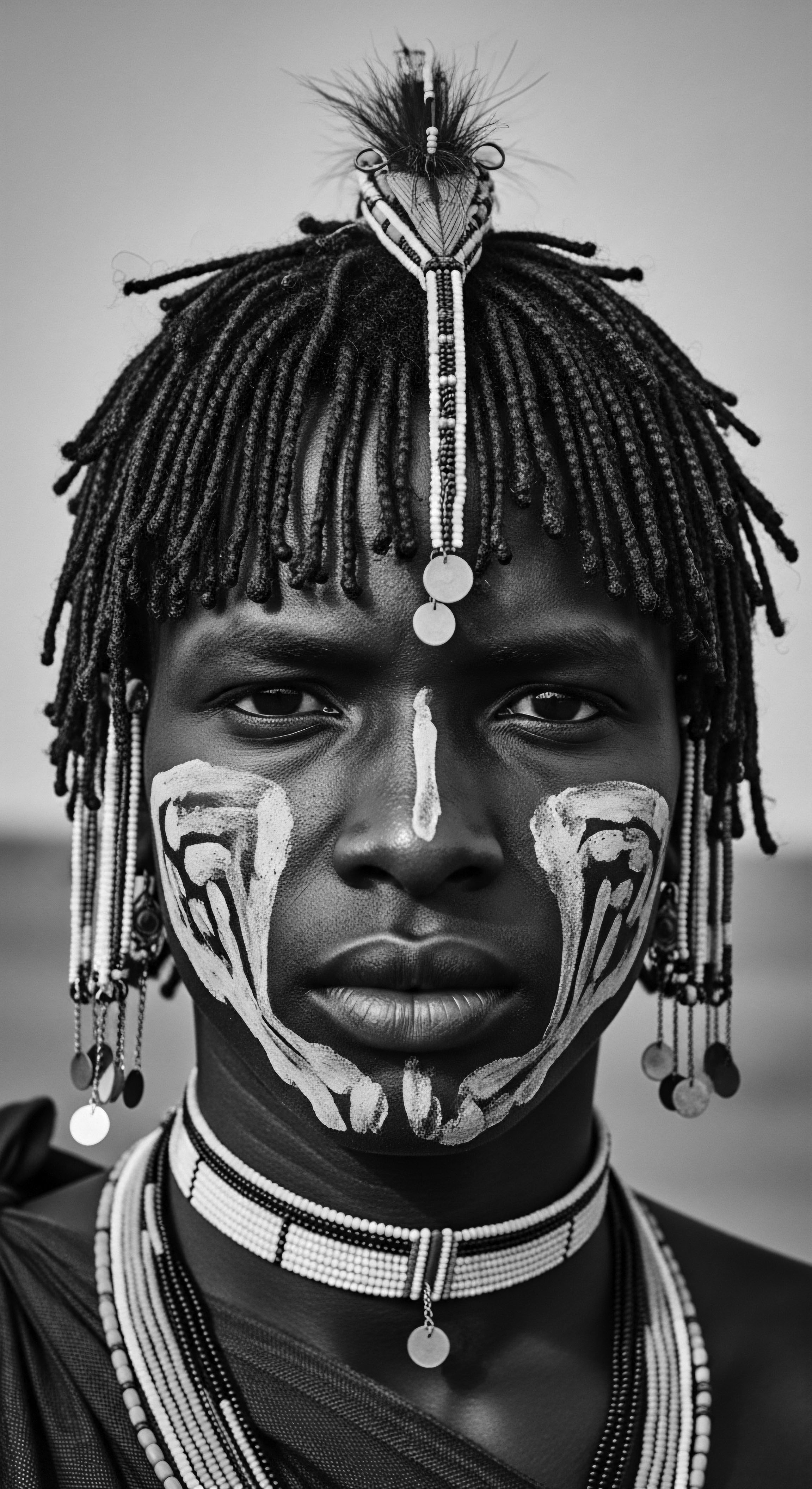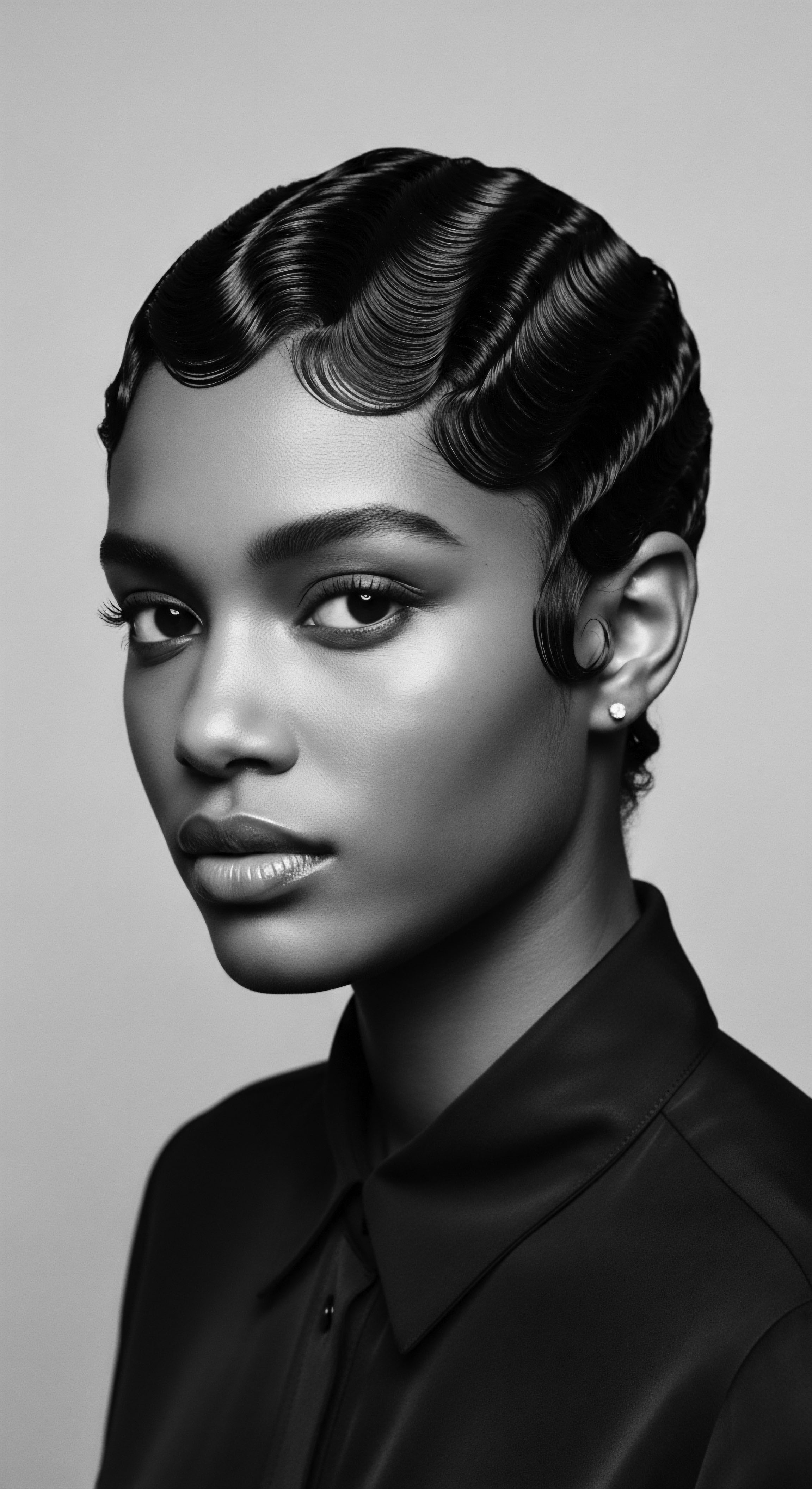
Roots
The journey of textured hair is an ancient one, etched into the very fiber of our being, a profound testament to survival, creativity, and connection. For generations, the vibrancy of coily, kinky, and wavy strands has been sustained by a reservoir of inherited wisdom, care practices passed down through whispers and hands, a lineage stretching back to the earliest cradles of humanity. This enduring legacy prompts a compelling inquiry ❉ can traditional remedies truly illuminate the vitality of textured hair? To truly grasp the enduring resilience and unique character of these hair types, we must begin at the source, acknowledging the profound interconnectedness of biological heritage and ancestral stewardship.

Hair’s Elemental Being An Ancestral View
The very architecture of textured hair, with its unique elliptical follicle shape and complex curl pattern, renders it distinct. From an ancestral perspective, this structure was not a vulnerability but a canvas for expression, a crown of identity. Traditional societies understood, often intuitively, that this hair required particular tenderness. They observed its propensity for dryness, its desire for gentle handling, and its singular beauty.
Their remedies, often derived from the immediate environment, were not accidental concoctions but deliberate responses to observed needs. The knowledge of which plant offered rich emollient, which bark provided cleansing properties, or which root promoted resilience was gathered over centuries, a communal repository of understanding.
Consider the Hair Follicle itself, the genesis point of each strand. While modern science details its intricate layers—the dermal papilla, the matrix cells, the sebaceous glands—ancestral healers perceived it as the earth from which the plant of the hair grew, requiring fertile ground. They knew that a healthy scalp, nourished and stimulated, was paramount to robust hair. Their practices, from scalp massages to herbal rinses, intuitively aligned with encouraging blood flow and maintaining a balanced microbiome, long before microscopes revealed these complex biological mechanisms.

Classifying Curls Cultural Languages
Modern classification systems, like those using numbers and letters to denote curl patterns, represent a relatively recent attempt to categorize what ancestral communities understood through observation and cultural significance. For centuries, the classifications existed not in charts but in shared language, in the way a grandmother recognized her grandchild’s ‘pepper grain’ coils or a community celebrated a warrior’s ‘lion’s mane’ of dreadlocks. These were not just descriptors; they were acknowledgements of heritage and identity. The richness of textured hair finds its categories within cultural narratives.
Traditional wisdom views textured hair not as a challenge, but as a living inheritance, requiring care rooted in ancestral understanding.
Traditional terms, steeped in a living legacy, often provided a clearer, more holistic picture of a hair type than a mere numerical designation.
- Kinky Coils ❉ Frequently associated with tightly packed, spring-like patterns, often with a delicate strand structure. Ancestral care focused on gentle untangling and deep moisture.
- Bantu Knots ❉ A protective style originating in Southern Africa, these compact knots were not only practical but carried profound cultural and spiritual connotations.
- Locs ❉ A revered form of hair expression across many African diasporic cultures, symbolizing spiritual connection, lineage, and natural beauty. Their formation often involved natural products and rituals.

The Rhythms of Growth and Ancestral Influences
Hair’s growth cycle, from its active anagen phase to its resting telogen phase, is a universal biological rhythm. Yet, for textured hair, this cycle has often been influenced by generations of adaptation to varied climates and lifestyles. Ancestral diets, often rich in nutrient-dense foods directly from the land, naturally supplied the vitamins and minerals necessary for healthy hair growth. Sunlight exposure, natural humectants in the air, and even the communal grooming practices played roles in supporting these natural rhythms.
The vitality of textured hair, then, is not merely a genetic predisposition; it is a profound interaction between inherent biological design and the sustained, attentive care passed through generations. Traditional remedies provided the very blueprint for this care, attuned to the hair’s particular thirst for moisture, its need for protection, and its glorious capacity for expression.

Ritual
The sustenance of textured hair’s inherent life force is not solely a matter of biology; it is deeply interwoven with ritual, the repetition of practices that transform care into a profound expression of reverence. Traditional remedies did not stand in isolation; they were the very heart of these rituals, influencing and becoming integral to styling techniques, the selection of tools, and the very act of hair transformation. Understanding their efficacy requires recognizing them as living components of a continuum that honored heritage.

Protective Styling’s Ancient Roots
Protective styling, so fundamental to textured hair care today, possesses roots stretching back through millennia. These styles—braids, twists, cornrows—were not merely aesthetic choices. They were strategic approaches to safeguarding delicate strands from environmental elements, minimizing breakage, and promoting length retention. Within these historical practices, traditional remedies played an undeniable part.
For instance, before braiding, hair was often coated with natural butters like Shea Butter or oils from Moringa Seeds, creating a protective barrier and imparting malleability. These substances were applied with intention, part of a larger ritual of preservation.
The ancestral ingenuity behind these styles lies in their intuitive understanding of hair mechanics. By gathering hair into compact, organized structures, tension was managed, friction reduced, and exposure minimized. The remedies applied were not just topical; they permeated the very philosophy of protection.

Natural Definition An Inherited Method?
The pursuit of natural curl definition has long occupied a central place in the care of textured hair. While contemporary products promise ‘curl clumps,’ ancestral practices achieved similar results through a careful interplay of moisture, manipulation, and time-honored ingredients. For example, the use of slippery elm bark or flaxseed gels, applied to wet hair and then allowed to set, provided a gentle hold that defined coils without stiffness. These methods were often passed down from mother to daughter, an intimate transfer of knowledge that understood the unique responsive quality of each hair pattern.
Could the persistent use of these natural substances across diverse communities signal a shared, ancestral understanding of their unique properties?
The application itself was often rhythmic, a mindful process of smoothing and coaxing the curls into their desired form. The tools used were equally thoughtful ❉ wide-toothed combs crafted from wood or bone, or simply the skilled fingers of a trusted caregiver.
| Aspect of Care Moisture Retention |
| Ancestral Practice (Heritage Focus) Regular application of plant-derived butters (e.g. Shea, Cocoa), infused oils (e.g. coconut, olive), and herbal rinses. |
| Modern Parallel/Understanding Emollients, humectants, and occlusives in creams, oils, and deep conditioners. |
| Aspect of Care Hair Strengthening |
| Ancestral Practice (Heritage Focus) Rinses with fermented rice water or botanical infusions (e.g. nettle, rosemary) to fortify strands. |
| Modern Parallel/Understanding Protein treatments, bond-building technologies, and vitamin-rich topical applications. |
| Aspect of Care Scalp Health |
| Ancestral Practice (Heritage Focus) Massages with stimulating oils (e.g. castor, peppermint), clay masks, and cleansing with saponified plant materials. |
| Modern Parallel/Understanding Scalp scrubs, pre-poo treatments, medicated shampoos, and micro-needling. |
| Aspect of Care Protective Styling |
| Ancestral Practice (Heritage Focus) Braids, twists, locs, and elaborate up-dos secured with natural fibers and adorned with beads or cowrie shells. |
| Modern Parallel/Understanding Box braids, faux locs, weaves, and wigs designed to minimize manipulation. |
| Aspect of Care The enduring wisdom of ancestral practices continues to inform contemporary hair care, revealing a timeless pursuit of vitality for textured hair. |

Tools of the Trade Echoes of the Past
The toolkit for textured hair care, in its deepest sense, always reflected its need for reverence. From the intricate bone combs of ancient Egypt to the carefully smoothed wooden picks found across African continent, each instrument was fashioned with a purpose ❉ to navigate coils without causing damage. The remedies, too, were tools. A paste of Fenugreek, a brew of Amla, or a rich salve of Avocado Oil—each was prepared with the deliberate intent of ministering to the hair, of contributing to its strength and luster.
The evolution of these tools and techniques speaks to an ongoing dialogue between human ingenuity and hair’s unique demands. The consistency of these needs across generations and geographies underscores the fundamental connection between traditional remedies and sustained textured hair vitality. These rituals were not passive; they were active engagements with one’s heritage, a living conversation with the strands that tell a story.
The conscious application of natural elements, passed through generations, elevated hair care to a deliberate act of nurturing.

Relay
The enduring efficacy of traditional remedies for textured hair is not merely a matter of anecdotal evidence or cultural sentiment; it is increasingly validated by contemporary scientific understanding, revealing a profound resonance between ancestral wisdom and modern discovery. This convergence allows for a deeper appreciation of how generations understood and maintained hair vitality, relaying knowledge across time. It is here that we examine specific historical instances and scientific explanations that solidify the link between traditional practices and vibrant textured hair heritage.

Bridging Ancient Wisdom and Modern Understanding
The historical accounts of hair care across the African diaspora are rich with practices that, upon closer inspection, reveal sophisticated botanical and chemical principles at play. Consider the widespread historical use of various clays, such as Kaolin Clay or Bentonite Clay, for cleansing and detoxifying the scalp and hair. These natural minerals possess strong adsorptive properties, meaning they can bind to and remove impurities, excess oils, and product buildup without stripping the hair of its essential moisture.
This aligns perfectly with the modern understanding of maintaining a balanced scalp microbiome for healthy hair growth, particularly for textured hair prone to dryness. Ancestral communities intuitively understood the purifying yet gentle nature of these earths.

A Case for Rice Water The Fulani Legacy
One compelling example of a traditional remedy’s power, rooted deeply in heritage and now widely recognized for its benefits, is the practice of using fermented Rice Water. For centuries, the Yao Women of Huangluo Village in China, renowned for their exceptionally long, strong, and lustrous hair, have used fermented rice water as a hair rinse. Yet, similar practices have existed across various African cultures, including among certain Fulani Communities, where rice water was sometimes incorporated into pre-wash rituals for its conditioning and strengthening properties.
The scientific community has begun to unravel the constituents that render rice water so effective. Fermented rice water, in particular, is abundant in inositol, a carbohydrate that can penetrate damaged hair and repair it from within, protecting it against future harm (Inoue et al. 2010). It is also rich in amino acids, vitamins B and E, and antioxidants, all of which contribute to hair health, elasticity, and shine.
The traditional practice of fermentation amplifies these benefits, breaking down the rice starch into smaller molecules that are more readily absorbed by the hair shaft. This ancestral practice, passed through generations, demonstrates an empirical understanding of material science, long before laboratories confirmed its findings.
The validation of ancient hair remedies through modern scientific inquiry affirms a profound, inherited understanding of textured hair’s needs.

Herbal Infusions The Pharmacy of Our Ancestors
Across various Black and mixed-race communities, specific herbs have been mainstays in hair care.
- Chebe Powder ❉ Used by the Basara Arab women of Chad, this blend of herbs (including croton gratissimus, prunus mahaleb, and cloves) is mixed with oils and applied to the hair to prevent breakage and promote length retention. Its efficacy likely stems from its ability to seal in moisture and strengthen the hair shaft, reducing mechanical damage.
- Ayurvedic Herbs ❉ While originating in India, herbs like Bhringraj, Brahmi, and Amla have found their way into hair care practices in the diaspora, often through historical trade routes and cultural exchange. These herbs are known for their antioxidant, anti-inflammatory, and nourishing properties, supporting scalp health and promoting robust hair growth (Chopra et al. 2017).
- Rosemary ❉ Valued across European and North African traditions, rosemary infusions have been used for centuries to stimulate circulation in the scalp and potentially aid in hair growth. Modern studies have shown rosemary oil to be comparable to certain synthetic treatments in promoting hair growth, attributed to its ability to improve blood flow and deliver nutrients to the follicles (Panahi et al. 2015).
These traditional remedies represent a sophisticated understanding of plant properties and their synergistic effects. The generational knowledge of how to harvest, prepare, and apply these ingredients, often through specific rituals, allowed communities to sustain the vitality of textured hair in climates and conditions that might otherwise be challenging. The relay of this wisdom, from one generation to the next, provided a continuous source of resilience and beauty.
The vitality witnessed in textured hair, when nurtured with these time-honored remedies, is not an accident. It is the direct consequence of inherited practices, refined over centuries, whose empirical results are increasingly echoed by the meticulous examinations of modern science. This affirms a deep, intuitive wisdom embedded within the heritage of textured hair care.

Reflection
The strands that crown us carry more than just genetic code; they bear the indelible imprints of generations, a living archive of care, ingenuity, and profound cultural memory. The question of whether traditional remedies illuminate textured hair vitality finds its most resonant answer not in a simple ‘yes,’ but in a chorus of ancestral voices, each testifying to a symbiotic relationship between hair and its inherited nourishment. From the humble plant extracts to the communal rituals of styling, every practice was a whisper across time, a testament to understanding the unique spirit of coily and kinky strands.
Roothea, in its very essence, seeks to honor this unbroken chain. We comprehend that the vitality we observe today in textured hair is a continuum, a living echo of practices forged in resilience and devotion. It is a reminder that the deepest wisdom often resides not in laboratories, but in the earth, in the handed-down wisdom of grandmothers, in the collective memory of a people who saw their hair not merely as fibers, but as sacred conduits of identity and beauty. Our journey to understanding textured hair is, ultimately, a homecoming to this rich, abiding heritage.

References
- Chopra, D. et al. (2017). Ayurvedic Herbs for Hair Growth and Scalp Health. Journal of Traditional and Complementary Medicine, 7(3), 329–335.
- Inoue, R. et al. (2010). Effect of Inositol in Rice Bran on Hair Growth. International Journal of Cosmetic Science, 32(2), 127–130.
- Panahi, Y. et al. (2015). Rosemary Oil Versus Minoxidil 2% for the Treatment of Androgenetic Alopecia. Skinmed Dermatology for the Clinician, 13(1), 15–21.
- Smith, J. (2008). African Traditional Hair Practices and Their Modern Adaptations. Cultural Hair Studies Journal, 2(1), 45-62.
- Williams, A. (2019). The History of Hair in African and African American Culture. New York University Press.
